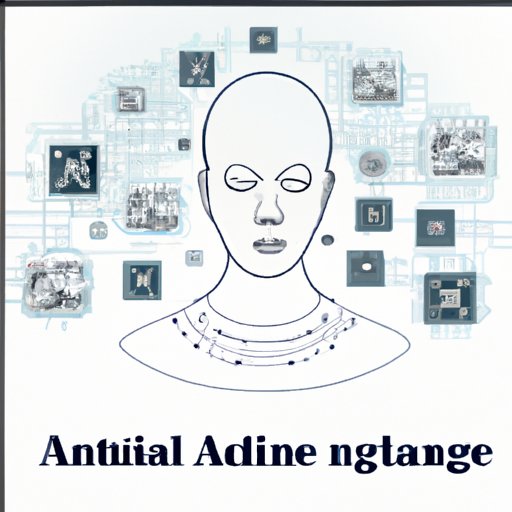Introduction
Artificial intelligence (AI) is a rapidly growing field of technology that has the potential to revolutionize many industries. AI is defined as the ability of a computer or machine to think and learn in a way that mimics human behavior. AI can be used for a variety of tasks, such as predicting outcomes, recognizing patterns, and making decisions. As AI continues to evolve, it is becoming increasingly important to understand how AI makes decisions and the implications of these decisions.
Exploring the Types of Artificial Intelligence and How They Make Decisions
There are several different types of AI that can be used to make decisions. Each type of AI uses different methods to process data and come to a conclusion. Here are some of the most common types of AI and how they make decisions:
Machine Learning
Machine learning is a type of AI that uses algorithms to identify patterns in data. The algorithms are trained on large datasets and then use those patterns to make decisions. For example, a machine learning algorithm might be used to analyze medical images to identify tumors or other abnormalities.
Deep Learning
Deep learning is a type of machine learning that uses neural networks to process data. Neural networks are made up of layers of neurons that are connected to each other. Each neuron processes information differently, allowing the network to recognize complex patterns in data. Deep learning algorithms are often used in image recognition and natural language processing.
Natural Language Processing
Natural language processing is a type of AI that enables machines to understand and interpret human language. It uses algorithms to analyze text and speech in order to interpret the meaning and context of what is being said. This type of AI is often used in voice recognition systems and chatbots.
Cognitive Computing
Cognitive computing is a type of AI that combines machine learning, natural language processing, and other technologies to enable machines to understand and interpret complex information. This type of AI is often used in medical diagnosis, legal decisions, and customer service applications.

Analyzing the Pros and Cons of AI Decision Making
AI decision making has both advantages and disadvantages. Here are some of the pros and cons of using AI for decision making:
Pros
- AI can make decisions faster than humans.
- AI can make more accurate decisions than humans.
- AI can process large amounts of data quickly and efficiently.
- AI can detect patterns that humans may not be able to identify.
Cons
- AI can be biased if the data it is trained on is not representative of the population.
- AI can be unpredictable and difficult to control.
- AI can be expensive to implement and maintain.
- AI can lack empathy, which can lead to suboptimal decisions.
Examining the Impact of AI Decision Making on Society
AI decision making has the potential to have a significant impact on society. Here are some of the possible impacts of AI decision making:
Automation of Jobs
AI decision making could lead to the automation of many jobs that were previously done by humans. This could lead to job losses in certain industries, especially those that require manual labor or repetitive tasks. It could also lead to an increase in wages for jobs that require more complex skills.
Increased Efficiency
AI decision making could lead to increased efficiency in many industries. AI algorithms can process large amounts of data quickly and accurately, which can lead to better decisions being made in less time. This could result in cost savings for companies and improved services for customers.
Improved Quality of Life
AI decision making could lead to improved quality of life for many people. AI algorithms can be used to diagnose diseases more accurately and efficiently, which could lead to earlier detection and treatment of illnesses. AI can also be used to automate tedious tasks, freeing up people’s time for leisure activities.

Investigating the Challenges in AI Decision Making
Although there are many potential benefits to using AI for decision making, there are also some challenges that must be addressed. Here are some of the challenges associated with AI decision making:
Limited Data Sets
One of the biggest challenges with AI decision making is the availability of limited data sets. AI algorithms need large amounts of data in order to be effective, but many companies do not have access to large datasets. Without access to enough data, AI algorithms may not be able to reach their full potential.
Bias in Algorithms
Another challenge with AI decision making is bias in algorithms. If an AI algorithm is trained on biased data, it may make decisions that are not representative of the population. This could lead to unfair decisions being made, which could have serious implications for individuals and society as a whole.
Unpredictability of Outcomes
AI decision making can also be unpredictable. AI algorithms are trained on data, but they cannot always predict how a decision will turn out in the real world. This can lead to unexpected results, which may not always be desirable.

Looking at How AI is Used to Automate Decision Making Processes
AI can be used to automate many decision making processes. Here are some examples of how AI is used to automate decision making processes:
Automation of Business Processes
AI can be used to automate business processes, such as marketing campaigns, customer service, and supply chain management. AI algorithms can be used to identify patterns in customer data and make decisions about how to best serve customers.
Automation of Legal Decisions
AI can also be used to automate legal decisions, such as sentencing in criminal cases. AI algorithms can be used to analyze data about a case and make recommendations about how to proceed. This can help reduce the amount of time required to make legal decisions.
Automation of Medical Diagnosis
AI can also be used to automate medical diagnosis. AI algorithms can be used to analyze medical images and make recommendations about diagnosis and treatment. This can help reduce the time required to make medical decisions and improve accuracy.
Conclusion
AI decision making has the potential to revolutionize many industries and improve the lives of many people. However, there are also some challenges that must be addressed, such as limited data sets, bias in algorithms, and unpredictability of outcomes. AI can also be used to automate decision making processes, such as automating business processes, legal decisions, and medical diagnosis. As AI technology continues to evolve, it is important to understand how AI makes decisions and the implications of those decisions.
(Note: Is this article not meeting your expectations? Do you have knowledge or insights to share? Unlock new opportunities and expand your reach by joining our authors team. Click Registration to join us and share your expertise with our readers.)
